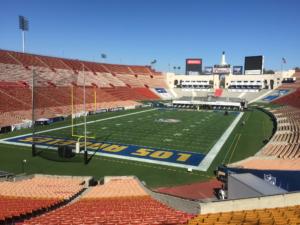Mar
Spring is on the Horizon – Arizona & California Turf Prep Tips
- Keep an eye on the temperature. At the point that it gets warmer than 65º at night consistently, you know you are ready for your spring transition.
- At this point, you can start reducing your water usage to about 70% (or even 80%) of your normal usage. This is a process that helps support the bermudagrass or paspalum (as it begins to kill the ryegrass). Note: do not try to do any drastic methods for this, such as halting watering altogether or scalping your lawn. This not only kills the winter rye grass, but also the hibernating warm season grass.
- Now we want to allow more sunlight to reach your warm season grass. We can effectively do this by verticutting the grass, which will allow the grass to open up its canopy. That process then allows more sunlight to get to the warm season grass.
- Aeration is the next step and this process breaks up hard pockets of soil and increases water penetration as well as nutrient intake, among many other things that help the warm season grass.
- You will need to start lowering your mower settings while increasing your mowing intervals to twice weekly, making sure the height of the grass doesn’t exceed a half inch (or at the highest, ¾ inch). Bag your clippings when you’re done!
- Fertilize your warm season grass and increase your watering schedule. It should take about two weeks before you see the bermudagrass overtaking the ryegrass. Gradually, you’ll increase your watering to a typical summer watering schedule.
Sep
Winter Overseeding Your California and Arizona Sod Lawn
We often see overseeding your warm season California or Arizona sod lawn as a process that should be done in a weekend. For some this may be the most convenient way to prep but for others its okay to take a week or two to complete the process. Trying to knock it all out in one weekend can result in some really long days out in the heat. My suggestion is to slowly start the process now so in a couple weeks when the overseed window opens you’re ready to go and won’t be wasting your entire Saturday on the lawn. Remember that the ideal window is when nighttime temperatures are in the 60’s. We’re currently sitting in the high 70’s so I would expect a couple more weeks. To follow overseed instructions scroll to bottom of this blog.
Prepping for overseed is often a large ordeal, but starting the process gradually can eliminate a lot of headaches. I want to reiterate something I have said for the past few years. The height of the grass is not associated with a quality overseed. In other words, scalping the grass down to the dirt does not guarantee good results, but opening up the turf canopy does. The shorter you mow your lawn the tighter the leaf blades become making it harder to get the ryegrass seed into the plant. If the seed is lying on the surface it will be slow to germinate and much of the seed will be lost. The seed needs a base to grow out of, and getting inside the grass plant allows for perfect moisture, heat, and a solid growing medium. This is why it’s so important to have a good warm season grass base. If you have a new lawn or a weak summer lawn it can have a direct impact on your overseed. The seed will establish much faster inside a healthy grass stand than it will on bare dirt.
Comments Off on Winter Overseeding Your California and Arizona Sod LawnSep
Pre-Overseeding Tips for Your Lawn
I would like to start by congratulating everyone on making through another California and Arizona summer. I know we still have a couple months of triple digit temperatures, but the worst should be behind us at this point. As we move into September our morning temperatures will start to feel less painful, but remember your warm season grass is loving this weather–especially your California and Arizona sod. I have started to field questions regarding fall overseeding and I want to tell you to hit the brakes. Don’t just tap the brakes, slam on the brakes. You will see ryegrass hit the stores in the next week but walk away or buy it and sit on it until temperatures really drop. Today I want to discuss prep for the fall, and how to get your grass ready to overseed. This won’t be a tutorial on how to overseed, but instead some pointers of what to do before you overseed.
Comments Off on Pre-Overseeding Tips for Your LawnMar
Seashore Paspaulum and Spring Transition for Your Warm Season Lawn
Arizona Diamondbacks
As many of you know BOBSod has been the turf of choice for the Diamondbacks since its conception in 1998, but this year we made a change. The Diamondbacks grounds crew experimented with a few different varieties over the last year and they decided to make the change to the environmentally friendly Platinum TE seashore paspalum. While the BOBSod is still performing at an extremely high level, a shift was made to go with a grass that could be installed without overseed in early March. For those not familiar with paspalum one of its best attributes is its shorter dormancy period. Paspalum can handle temperatures that drop into the 40’s at night before losing color while bermudagrasses will start to lose color in the 50’s. This often leads to a 3+ weeks longer season in the fall and can often green up a few weeks earlier in the spring.
Having the roof over Chase Field provides a lot shade during the spring transition and can really extend the life of the ryegrass. As you probably have learned from your bermudagrass lawns over the years shade will take out your grass over time. Since the ryegrass can live longer inside the stadium, it makes for a longer transition. With this in mind the groundskeeper decided to make the choice to use a non overseeded grass and avoid any transition.
Comments Off on Seashore Paspaulum and Spring Transition for Your Warm Season Lawn
Nov
You Have Overseeded Your California or Arizona Sod Lawn–Now What? And….Even if You Haven’t.
By now most of you who are going to overseed have either begun the process or have had your seed down for a few weeks. Today I want to discuss what to do now that you have the ryegrass growing and cooler temperatures are on the horizon.
Getting your ryegrass up and growing is obviously the first step to a successful winter lawn but what about maintenance? How can you make sure your ryegrass is strong going into the winter and you will have a full stand of ryegrass once the temperatures begin to drop into the 40’s at night? There are several key items associated with a strong winter lawn but early preparation should be high on your list.
Comments Off on You Have Overseeded Your California or Arizona Sod Lawn–Now What? And….Even if You Haven’t.Oct
Fall California and Arizona Lawn Care
Time to Tune Up Your Turf

Fall is the perfect time to fine tune your lawn. By preparing your warm season turfgrass for dormancy and overseeding with ryegrass for the cool season, you can take the necessary steps to ensure your lawn stays green throughout the holidays and into spring. If you’ve already overseeded, or are still planning to overseed then these Arizona lawn care tips will help you make the most of your lawn this fall.
We’re filling you in on the best way to fertilize, water, mow and maintain both your cool season turf and your dormant warm season sod. Read the rest of this entry »
Comments Off on Fall California and Arizona Lawn CareSep
FAQ About Fall Overseeding of Your Warm Season Grasses
A couple weeks ago I put out a post on overseeding and now that we’re through September it’s time to get the process started. Click here for the previous post on overseeding for full instructions. In today’s blog I wanted to pass along some of the most frequently asked questions during this time of the year.
When is the best time to start overseeding?
Ideally overseeding should be done when nighttime temperatures are consistently in the 60’s. Typically this will be the month of October. Obviously there will be some spikes and lower than normal temperatures during this period but anytime during October is good.
How low do I need to scalp the grass prior to seeding?
The height of the grass isn’t as important as opening the turf canopy. The shorter you mow the grass, the tighter the turf canopy will be which will result in the need to verticut more aggressively. I recommend not going lower than ½”. There is no need to take the lawn to the dirt or you will cause long term problems to the grass plant. Read the rest of this entry »
Sep
California and Arizona Sod Tips: It’s ALMOST Time to Overseed Your Lawn!
With the recent heavy rains and slightly cooler temperatures no doubt people are thinking about overseeding their California and Arizona lawns. While the calendar says September 18th and you will surely see people overseeding, I suggest you wait a few weeks. Follow my California and Arizona sod tips for a beautiful lawn. Overseeding does not need to be a one day process. You can begin the process a little early. Then, when temperatures are in the 60’s at night, you will just need to give your lawn one last haircut, drop the seed and begin watering.
Preparing to Overseed
Prepping for overseed is often a large ordeal. By starting the process gradually you can eliminate the headaches associated with trying to do it all in one afternoon. I want to reiterate something I have been saying for the past few years. The height of the grass is not associated with a quality overseed. In other words scalping the grass down to the dirt does not guarantee good results. Opening up the turf canopy does.
The shorter you mow your lawn the tighter the leaf blades become. This makes it harder to get the ryegrass seed into the plant. If the seed is lying on the surface it will be slow to germinate and much of the seed will be lost. The seed needs a base to grow out of. Getting inside the grass plant allows for perfect moisture, heat, and a solid growing medium. By looking at my last statement you can now understand why I say without a good warm season grass base (used on popular California and Arizona lawns) you will most likely have a poor ryegrass season. The seed will establish much faster inside a healthy grass stand than it will on bare dirt.
Comments Off on California and Arizona Sod Tips: It’s ALMOST Time to Overseed Your Lawn!Aug
Summer Tips for Your Sod Lawn in Arizona and California
Summer is wrapping up, the kids are heading back to school, and I’m sure you’re ready to come out of hibernation. While the summer heat is far from over in Arizona and California, it’s starting to become tolerable outside. With the slightly cooler mornings it’s time to get back outside and get your lawn ready for fall. Most people start thinking about overseeding their California and Arizona sod in September, but ideally you wouldn’t start the process until October when nighttime temperatures get into the 60’s. Between now and then there are some important steps you need to do to get your lawn ready and to save some headaches down the road.
Between May and September you probably noticed your lawn has grown at twice the rate it does during the winter months. Warm season grasses love the warm, wet weather. Most people thought the hot weather would keep the grass from growing well, but remember warm season grasses optimal growing temperatures are between 90-105 degrees. During this season any of your weaker areas should have filled in with the warm season grasses runners. These spots can be slow to fill in during the dry, hot days but as soon as the humidity kicks in the grass really takes off. If you still have large open spots I would suggest picking up a few rolls of sod and patching them prior to overseed. You don’t want to seed directly into the soil.
Comments Off on Summer Tips for Your Sod Lawn in Arizona and CaliforniaDec
Winter Tips for Your Lawn
Cold temperatures have arrived in California and Arizona, and those of you with overseeded sod may begin to see your lawn go in a little shock. One of the things you will notice first is bermudagrass going dormant in the turf causing small quarter sized yellow spots in your lawn. This is nothing to be concerned about as today we will discuss getting those spots to fill in. If you didn’t overseed your lawn for the winter it’s most likely dormant at this point and you can sit back and let your lawn sleep for a few months.
I’m sure many of you have seen the small yellow spots over the years in your overseeded lawn. The question is what is causing it and what can you do about it? First, this isn’t something to be concerned about. It’s actually a sign that you had a very healthy lawn going into the overseed season. Since many people overseed in late September/early October you’re still fighting with warm season growth. By supplying water and fertilizer to overseed the bermudagrass continues to grow and has a tendency to out compete your newly seeded ryegrass. When you’re overseeded lawn first start growing it looks immaculate, but it’s good to remember some of this is bermudagrass. The bermudagrass/ryegrass combination looks incredible and when it’s growing in it can be tough to distinguish the two.
Comments Off on Winter Tips for Your Lawn






